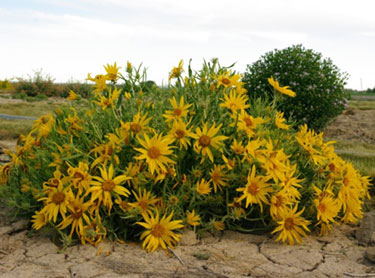Scabland Mule’s Ear in the Landscape

Stephen Love, University of Idaho
Scientfic Name: Wyethia scabra, (syn. Scabrethia scabra)Common Name: Scabland mule’s ear, rough mule’s ear, badland mule’s ear, desert mule’s ear
Description: Scabland mule’s ear is a long-lived, mounding perennial that can provide months of summer and early fall bloom. Mature plants are up to 20 inches tall and over time become up to 3 feet across. Plants produce numerous slender, floppy or arching stems. Stems and leaves are covered with stiff, bristly hairs, giving the foliage the texture of course sandpaper. Plants are herbaceous, each winter dying back to a woody crown and producing regrowth each spring. The horticultural value of this species is the large, showy sunflower-like blossoms that appear in late June and last sporadically into fall. Scabland mule’s ear can be used in xeric beds or borders or as a component in a xeric meadow.
Native Habitat: Wyethia scabra inhabits desert and semi-desert regions in the eastern Rocky Mountain states, from Wyoming south to Arizona and New Mexico. It grows on slopes and mesas in juniper and pinyon pine communities, primarily on sandy or calcareous soils. This species grows at elevations ranging from 3,400 to 6,000 feet.
Cultural Requirement
Soil: Prefers sandy or well-drained alkaline soils. Requires minimal soil fertility.
Moisture Tolerance: Long-lived only when moisture conditions are dry to moderately dry. Requires some supplemental water in areas with less than 10 inches of annual precipitation.
Sun/Shade/Preference: Prefers full sun.
Transplanting: Performs best if seeded directly into a deep pot and pot-to-pot transplanting avoided. This species transplants easily from a deep pot into the garden. Potted plants grow at a moderate pace after transplanting and usually bloom sporadically the first season.
Propagation: Best grown from seed. Seeds require no stratification or other pretreatment and consistently germinate at relatively high rates. Young seedlings grow comparatively slowly and need good drainage to thrive in pots. Plants can bloom in the pot if given enough time. With good watering practices, plants of this species can be produced in pots up to 1-gallon size.
Maintenance (pruning, fertilization, deadheading, division, irrigation, etc): Scabland mule’s ear is a relatively carefree species. In order to keep plants attractive, remove persistent dead stems from the previous season in late fall or early spring. Supplemental irrigation is required only in the driest of Intermountain regions. Fertilizer is required only if plants show poor vigor.
Insect, disease, or other problems: Scabland mule’s ear typically shows no problems with pests or diseases.
Landscape Value
Use in the Landscape: Scabland mule’s ear can be a prominent plant in the landscape and easily treated as a specimen. As a companion plant, this species can be planted among shorter perennials. It provides color for hell-strips and other harsh sites and can give structure and color to a xeric meadow.
Weediness/Invasive Potential: Scabland mule’s ear is not weedy from seed nor does it spread from rhizomes.
Foliage: Numerous stems of scabland mule’s ear emerge from a woody crown. Stems are free and unbranched from the base and radiate in all directions. The overall effect is of a large, loose mound. Leaves form on the flowering stems and have a narrow, long shape. All parts of the foliage are covered with stiff, short hairs, giving a rough sandpaper-like texture. By itself, the foliage lacks significant appeal.
Flower: Flowers are large (up to 6 inches in diameter) and have the color and form of sunflowers. Ray flowers in the composite head are dark yellow, long and fairly broad. Disk flowers are brown, providing a brown center. Flowers are plentiful and completely cover the plants when in full bloom.
Timing: June-September.
Fruit: Each flower head produces numerous fruits consisting of long, black achenes (seeds).
Form: Nearly symmetrical loose mounds.
Texture: Coarse.
Ultimate Size: Over a period of several years, plants grow into prominent mounds that are about 2 feet tall and up to 3 feet wide.
Rate of Growth: Scabland mule’s ear grows at a moderate rate and continues to grow larger over a period of years. Plants typically produce at least a few flowers their first season in the garden.
Suggested Plant Partners: Place plants of scabland mule’s ear in beds and mixed borders to serve as specimen plants or to provide repetition. Surround them with smaller perennials and low shrubs, such as: purple sage (Salvia dorrii), Cusick’s hyssop (Agastache cusickii), pineleaf penstemon (Penstemon pinifolius), sidebells beardtongue (Penstemon secundiflorus), firechalice (Epilobium canum), lacy buckwheat (Eriogonum corymbosum), Idaho fescue (Festuca idahoensis), andblue grama (Bouteloua gracilis).
Availability: Occasionally available as potted plants from local or mail-order native plant nurseries. Seed can be purchased from native plant seed suppliers.
Cultivars: No cultivars available.
References:

